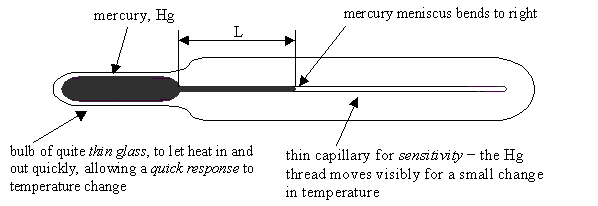Table of Contents
Key Points Of A Laboratory Thermometer
Structure
- The thermometer is made relatively small so that it is portable and cheap.
- The liquid is contained in a thin-walled glass bulb. The bulb is made relatively larger than its bore to contain more of the liquid, so as to improve sensitivity.
- The narrow bore of the capillary tube is uniform. The round glass stem around the capillary tube is made thick. It acts as a magnifying glass.
Sensitivity
- Small expansion of the liquid in the liquid bulb will cause a big change in the length of the liquid thread in the capillary tube as it is made narrow. The narrower the bore, the higher the sensitivity.
Range
- The range is limited by the freezing and boiling points of liquid.
For mercury thermometer: -39 to 357°C
For alcohol-in-glass thermometer: -115 to 78°C - In colder countries, most of its liquid-in-glass thermometers use alcohol and not mercury.
- The range can be increased by lengthening the bore.
- Range is the converse of sensitivity, i.e., the longer the range, the lower is its sensitivity. Factors that increase range would at the same time reduce its sensitivity.
Linearity
- Mercury expands quite uniformly over a good range of temperatures.
- Alcohol expands non-linearly over different range of temperatures.
Responsiveness
- As the liquid is contained in a thin-walled, small glass bulb, it will be more responsive (faster response) to heat.
- Mercury reacts quickly to the temperature changes whereas alcohol reacts slowly.
- It takes several tens of seconds to record one reading.
Further Discussion On Laboratory Thermometer
Laboratory thermometers are indispensable tools in scientific research, providing precise and accurate temperature measurements essential for a wide array of experiments and analyses. These specialized thermometers are designed with meticulous attention to detail to meet the demanding standards of laboratory environments, where accuracy is paramount.
Anatomy Of A Laboratory Thermometer
1. Construction:
Laboratory thermometers are typically constructed with a glass or metal outer casing to ensure durability and resistance to chemical exposure. The choice of materials often depends on the specific applications and substances the thermometer might come in contact with.
2. Bulb and Capillary Tube:
The thermometer features a bulb at one end, usually containing a mercury or alcohol-filled reservoir. The bulb and a thin capillary tube connected to it facilitate the expansion and contraction of the liquid with temperature changes.
3. Scale:
The temperature scale is meticulously marked along the length of the capillary tube. Common temperature scales used in laboratory thermometers include Celsius and Kelvin, depending on the scientific community or region.
4. Calibration:
Laboratory thermometers undergo precise calibration processes to ensure accuracy. Calibrations are often traceable to international standards, contributing to the reliability of the measurements.
Applications Of Laboratory Thermometers
1. Chemical Reactions:
Laboratory thermometers play a crucial role in monitoring temperature variations during chemical reactions. This information is vital for understanding reaction kinetics, optimizing conditions, and ensuring the safety of experiments.
2. Biological Studies:
In biological research, maintaining specific temperature conditions is often critical. Laboratory thermometers are used in incubators, refrigerators, and water baths to regulate and monitor temperatures for various biological experiments.
3. Physics Experiments:
In physics laboratories, precise temperature measurements are essential for experiments involving heat transfer, thermodynamics, and other temperature-dependent phenomena. Laboratory thermometers aid in maintaining controlled conditions for accurate results.
4. Quality Control in Industry:
Industries, especially those involved in pharmaceuticals and food production, rely on laboratory thermometers for quality control. Ensuring precise temperatures in manufacturing processes is crucial for maintaining product consistency and safety.
5. Calibration of Other Instruments:
Laboratory thermometers often serve as reference standards for calibrating other temperature-measuring devices, ensuring the accuracy of a broader range of instruments used in scientific and industrial settings.
Specialized Types Of Laboratory Thermometers
1. Precision Liquid-in-Glass Thermometers:
These thermometers use a liquid column, typically mercury or alcohol, to measure temperature accurately. They are suitable for a wide temperature range and exhibit high precision.
2. Gas Thermometers:
Gas-filled thermometers are designed for extreme temperature conditions. They rely on the expansion and contraction of gases to measure temperatures accurately in challenging environments.
3. Digital Laboratory Thermometers:
Incorporating digital technology, these thermometers provide a quick and easy-to-read display of temperature. They are often equipped with additional features like data logging and connectivity for advanced laboratory setups.
Care & Handling
Proper care of laboratory thermometers is essential for maintaining their accuracy and longevity. Here are a few guidelines:
- Handle with Care: Laboratory thermometers are delicate instruments. Avoid rough handling or exposing them to excessive mechanical stress.
- Calibration Checks: Regularly check and recalibrate laboratory thermometers to ensure accurate readings. Many laboratories have established calibration schedules to maintain the precision of their instruments.
- Chemical Compatibility: Be mindful of the substances the thermometer may come in contact with. Choose thermometers with materials compatible with the chemicals used in experiments.
- Storage: Store laboratory thermometers in a secure location, preferably in a protective case, to prevent breakage and contamination.
Conclusion
Laboratory thermometers stand as silent sentinels in scientific laboratories, providing researchers with the crucial data needed for accurate experimentation and analysis. The meticulous design, precise calibration, and diverse applications make them an integral part of scientific advancements, ensuring that the pursuit of knowledge continues with unwavering accuracy.
